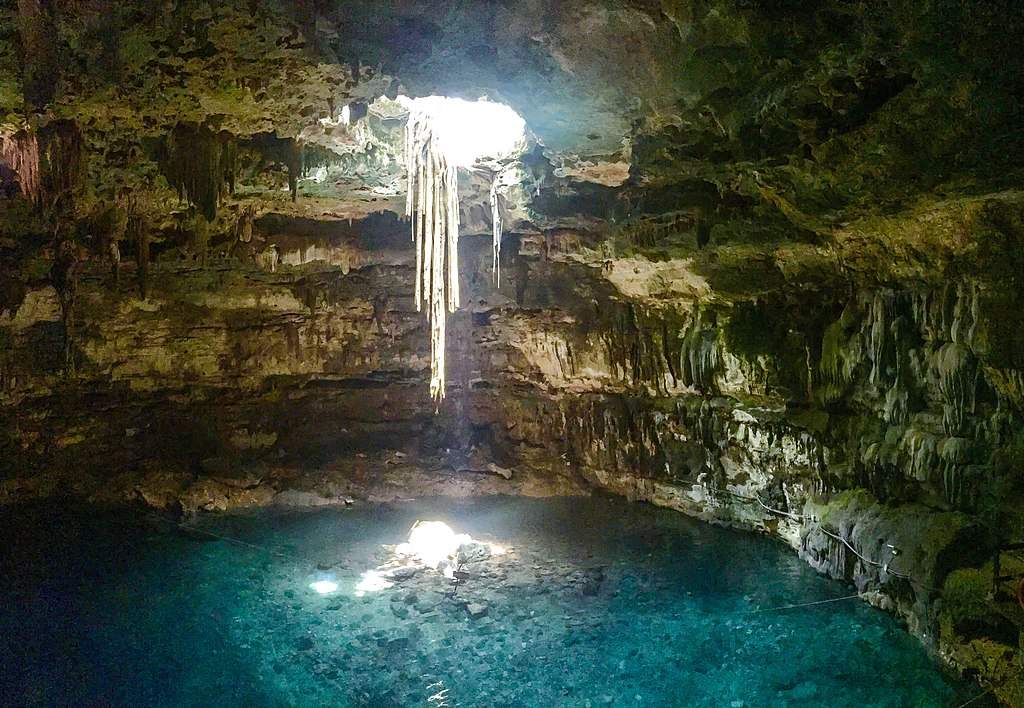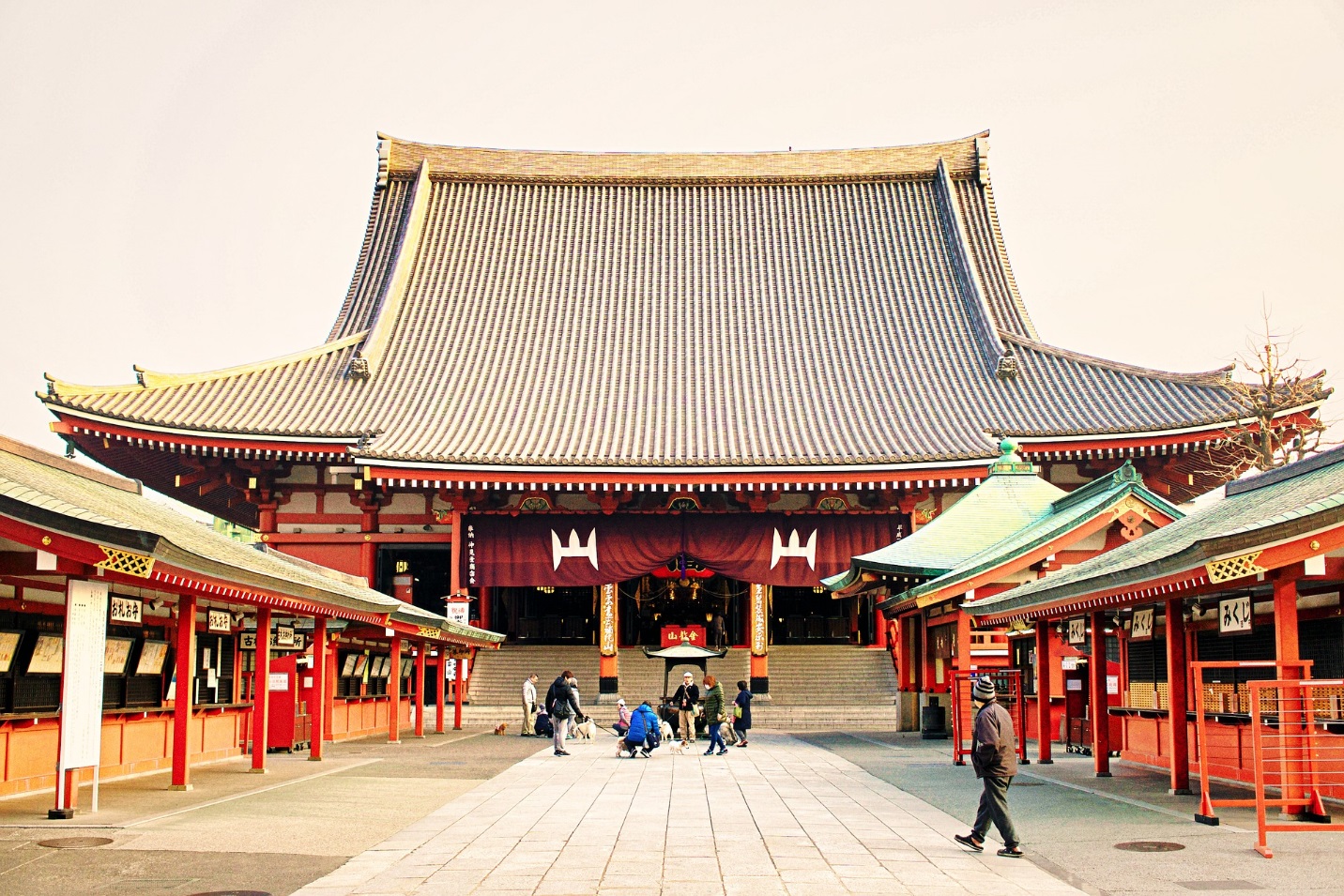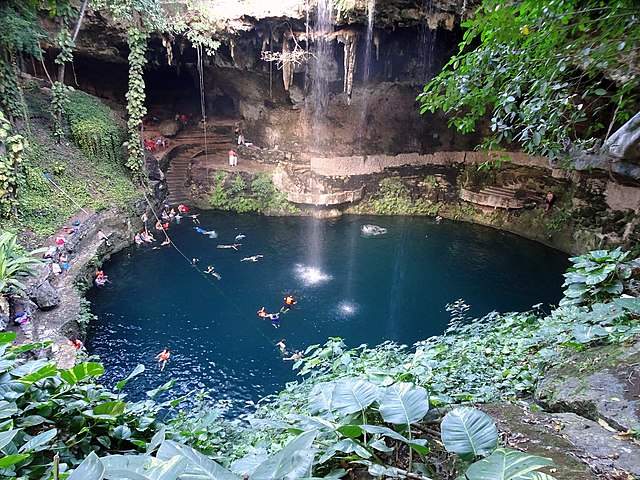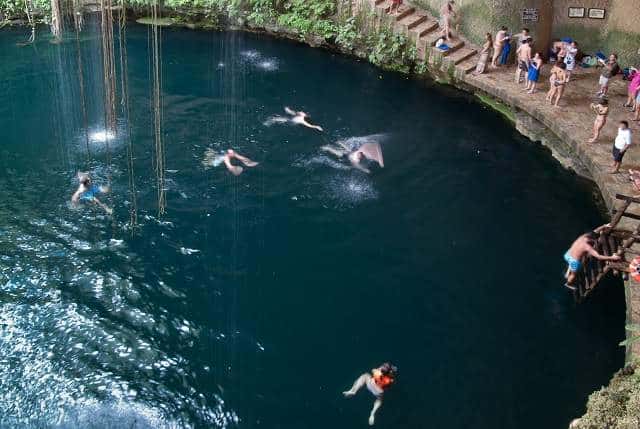
Embark on a Journey to Valladolid Cenotes: Mexico’s Hidden Wonders Await
Hello, fellow traveler! Have you ever heard of Valladolid Cenotes? If not, buckle up, because we’re about to embark on a virtual journey to one of Mexico’s best-kept secrets. You and I, we’re in for a treat!
Let’s set the stage: Valladolid, a small city in the heart of the Yucatán Peninsula, steeped in history and bursting with vibrant culture and tantalizing cuisine. But that’s not all – beneath its surface lie ethereal natural formations known as cenotes.
Now visualize this: a cenote is a natural sinkhole resulting from collapsed limestone bedrock, revealing a serene, crystal-clear underground pool. Sounds intriguing, right? But wait until you dive into the splendid cenotes of Valladolid!
These hidden gems are more than just pretty sights. They play a vital role in the culture of Valladolid and broader Mexico. In ancient Mayan society, they were considered sacred, thought to connect the surface world with the spiritual underworld. I know, intriguing stuff! To this day, cenotes continue to captify locals and travelers alike with their unspoiled beauty, laying claim to unbelievable snorkeling and diving experiences.
Not only do Valladolid’s cenotes offer a swim in serene azure waters; they also pack an invigorating dose of adventure. Fancy diving from rocky outcrops into awe-inspiring underwater caverns? Valladolid cenotes are your dream come true.
Valladolid’s cenotes are a testament to nature’s magical artistry, tucked away from the hustle of Mexico’s tourist trail, just waiting to be discovered. There’s a reason we call them ‘hidden gems’ – whether you’re a seasoned adventurer or a beginner in the world of travel, they offer a unique experience you won’t find anywhere else.
So there you have it, fellow explorer, a quick peek into the wonders of Valladolid’s cenotes. We have so much more to discover together as we delve deeper into the beauty and mysteries of these natural wonders. So stick around, because this is just the beginning of our virtual voyage into the alluring world of Valladolid’s cenotes!
Ready for the adventure of a lifetime? I knew you’d be! Let’s dive in, shall we?
Appreciating Valladolid’s Cenotes: Mexico’s Hidden Natural Masterpieces
Have you ever wondered about the natural beauty places tucked away, often unseen, within the folds of our earth? Get comfy, my friend, and let’s journey together into the heart of Mexico’s Valladolid, home to awe-inspiring natural wonders known as, wait for it… cenotes!
What on Earth is a Cenote?
To understand the appeal of Valladolid’s cenotes, we must first clarify what a cenote is. Well, you may ask, “What’s in a name?” Oodles, my friend, oodles – the term “cenote” comes from the Mayan word ‘Dzonot,’ which means ‘sacred well.’ In more geologically oriented terms, a cenote is a natural sinkhole created when limestone bedrock collapses, unveiling groundwater pools beneath. Now, doesn’t that sound intriguing?
The Cultural Significance of Cenotes
Cenotes were not just attractive swimming spots for the ancient Mayans. Oh no, these enchanted places had immense cultural significance. They were viewed as sacred pathways to the spiritual world. Mayans even believed they were portals to communicate with their gods. They offered precious commodities like jade and gold and conducted sacred ceremonies within the cenotes. Talk about a divine swim!
Valladolid’s cenotes continue to play an integral role in local communities. They are central to cultural identity and serve as essential water sources in the region. Indeed, for many locals, cenotes are a living testament to their rich ancestral history.
Marveling Over the Unique Geological Features of Cenotes
One of the most captivating aspects of Valladolid’s cenotes is their strikingly unique geological features. The surreal stalactite and stalagmite formations within the cenote chambers are sheer wonders of millennia-old nature’s artistry.
Even more exciting, some cenotes are half-filled with freshwater, while the bottom half is filled with saltwater. That’s the jaw-dropping result of a fascinating natural phenomenon called halocline – where freshwater sits atop denser saltwater, creating a blurry, dreamy underwater landscape. Picture snorkeling or diving through that!
Highlighting the Valladolid Cenotes
Today, we’re going to take you on a mesmerizing journey through the magical cenotes of Valladolid. Now, if you’re thinking, “What in the world is a cenote?”, no worries—you’re not alone. A cenote (pronounced “say-NOH-tay”) is a natural sinkhole created by collapsed bedrock, revealing a pool of water underneath. These watery gems in the Yucatan Peninsula are nothing short of extraordinary. Ready to jump in? Let’s go!
Journey into Valladolid Cenotes
Valladolid is a small city in Mexico’s Yucatan Peninsula. It’s known for its Spanish colonial architecture, rich culture, colorful history, and—most importantly for us—its stunning cenotes. Dotted all around Valladolid are these remarkable natural wonders. Today, we’ll take a closer look at some of the most alluring cenotes—Cenote Zaci and Cenote Suytun.
Cenote Zaci: The Heart of Valladolid
A Glimpse back into History
Located in the heart of Valladolid, Cenote Zaci—meaning White Hawk in the Mayan language—holds significant cultural and historical value. These cenotes were regarded as sacred by the ancient Mayans. Equally impressive are the stalagmites and stalactites you’ll find here, formed over thousands of years.
Unique Attractions and Activities
There’s something for everyone at Cenote Zaci. Adrenaline junkies can take a daring leap into the water from the clifftop, while nature lovers might prefer basking in the cenote’s unique ecosystem. From the trove of tropical fish to the stunning natural formations above the water, every sight in Cenote Zaci offers a unique snapshot of nature’s artistic flair.
Cenote Suytun: A Step into Serenity
Historical Significance
Cenote Suytun, which means ‘centre stone’ in the Mayan language, owes its name to the peculiar stony platform, from which rays of sunlight beautifully illumine the water below. The cenote’s significance dates back to the Mayans, who believed them to be the gateway to the underworld.
Main Attractions and Wondrous Features
Cenote Suytun boasts a truly tranquil and otherworldly atmosphere. The dramatic rays of sunlight that filter through the small opening in the cenote’s ceiling create an enchanting scene, illuminating the turquoise blue waters inside. You can also stroll around the cenote on the platform or take memorable photos in this photogenic heaven. Additionally, local artisans and vendors often sell beautiful crafts nearby, providing a lovely opportunity for you to take home a piece of this extraordinary locale.
Essential Tips for Visiting Valladolid Cenotes
So, you’re planning to visit the fantastic cenotes in Valladolid? That’s awesome! To make your trip as seamless and memorable as possible, we’ve compiled a handy guide with essential tips covering everything from the best time to visit, engaging activities, to safety measures. Let’s dive right in!
When to Visit Valladolid Cenotes
Timing is key to fully absorb the magic of the Valladolid cenotes. Generally, here’s what you need to keep in mind:
- Dry months – December to April: This period offers perfect conditions to visit cenotes. Less rain means clearer and more tranquil waters.
- Avoid mid-day rush – Plan to visit early in the morning or late afternoon to avoid the crowds. Plus, you might just catch that mystical sunbeam illuminating the cenote.
Activities and Guidelines at Valladolid Cenotes
Those crystal-clear waters are just begging for some fun, right? Here are some suggested activities:
- Swimming: The most popular (and obvious!) activity. Bring your swim gear and enjoy the refreshing waters.
- Snorkeling: Want to have a look at aquatic life in the cenote? Snorkeling could be your perfect bet.
- Photography: The stunning cenotes can give professional photography spots a run for their money!
Remember, every cenote has its rules to preserve their natural beauty. Respect the signage and stick to designated paths.
Stay Safe and Respect the Environment
Safety first, always:
- Wear a Life Vest: Not a strong swimmer? Life vests are usually available for rent at the cenote.
- Avoid Touching Formations: The limestone formations take years to form—let’s give them the respect they deserve.
Being eco-conscious plays a significant role too:
- Use Biodegradable Sunscreen: Regular sunscreens can harm the cenote’s delicate ecosystem.
- Don’t Litter: This one’s a no-brainer—let’s do our part to keep the cenotes clean and beautiful for everyone.
With these tips and guidelines in hand, you’re now all set for a safe, captivating, and unforgettable experience in Valladolid cenotes. Enjoy the adventure, fellow explorer!
Your Guide to Travelling to Valladolid Cenotes
Packed your swimsuits and ready to explore the enchanting cenotes of Valladolid? Great! Before we dive into the turquoise waters, let’s go over some practical travel information to make your journey smoother.
Reaching Valladolid
Valladolid, with its rich history and vibrant culture, is nestled right in the Yucatan Peninsula of Mexico. Want to know how to get there? Let’s navigate:
- From Cancún: A two-hour drive or a comfortable bus ride (ADO buses are reliable) can get you from Cancún to Valladolid.
- From Mérida: Valladolid is just about two hours by car from Mérida. Public buses are also an option, but the journey may be slightly lengthier.
Facilities and Services in Valladolid
Once you’re in this charming colonial city, you’ll find it is well-equipped to handle your travel needs:
- Accommodation: Ranging from budget-friendly hostels to luxury boutique hotels, Valladolid has lodging options to meet every traveler’s needs.
- Food: Step into the local markets or city restaurants to tantalize your taste buds with Yucatan cuisine.
- Transport: For moving within Valladolid, taxis and local buses are readily available. Some adventurous folks opt for bike rentals too!
Tech Friend in Need
Who says ancient cenotes and modern apps don’t mix? Get a leg up in your trip with these tools:
- Google Maps: Navigate through Valladolid streets and to the cenotes with ease. You can also download offline maps.
- TripAdvisor: Reviews from fellow travelers can guide you towards top-rated local restaurants and must-see attractions.
- Duolingo: A fun way to brush up on your Spanish before interacting with locals!
Don’t forget to save the local emergency number (911) in your phone contacts, just in case.
Voila! You are all set for a fantastic journey to the hidden gems of Valladolid. As we say in Mexico, “Buen viaje”, or have a great trip!
Capturing Valladolid’s Rich Culture
We know you’re excited to plunge into the ethereal cenotes of Valladolid. But there’s more to Valladolid than merely its underwater beauty. From riveting customs to mouth-watering cuisine, let’s soak up the vibrant culture of this quaint Mexican town together.
Valladolid: Where Tradition Meets Modernity
Valladolid has a rich heritage that beautifully blends Mayan traditions with influences from Spanish colonists. Here’s a snapshot of what you’ll encounter:
- Time Honored Traditions: Dance and music play a vital role in Valladolid’s culture. If you’re lucky, you might catch a traditional Jarana dance performance in the city square, where dancers gracefully skip and twirl to the strums of jarana guitars.
- Festivals: Events like Feast of San Bernardino, held in May, bring traditional customs and the local community’s camaraderie to light. Don’t miss the traditional Vaquería, where locals, attired in their best white Mayan tunics, celebrate the event with food, dance, and music.
- Art: Valladolid is home to many indigenous artists. Visit local markets to explore handmade crafts and textiles that beautifully depict Mayan legends and natural themes.
Local Foods to Savour & Products to Buy
While in Valladolid, your taste buds are in for a treat, and your shopping bags will fill quickly!
- Food: Try out Cochinita Pibil, a traditional Yucatan dish where pork is slow-cooked in citrusy marinade. Or sample the local street food, like Marquesitas, a crunchy dessert stuffed with Nutella or local cheese.
- Shopping: Head to Calzada de los Frailes for a shopping spree. Shop for local specialty goods like Mayan honey, hammocks, or Guayabera shirts. Don’t forget to pick up a bottle of the local liquor, Xtabentún—a sweet alcoholic drink made from anise and fermented honey.
Keep in mind, immersing oneself in the local culture is as enriching an experience as exploring the natural landscapes. So make sure to make the most of your visit by appreciating the local customs and satiating your palate with the delicacies of Valladolid. Trust us, it’s more than just cenotes!
Frequently Asked Questions: Valladolid Cenotes
We know how eager and curious you are about this upcoming adventure to the mesmerizing cenotes of Valladolid! It’s an experience quite like none other. With curiosity though, come questions. And that’s excellent because we’re here with answers to some of the most frequently asked questions about Valladolid’s cenotes. Shall we get started?
How do I reach Valladolid’s Cenotes?
Reaching Valladolid is a breeze:
- From Cancún: You can hop on a comfortable ADO bus or hire a car. It’s a smooth, two-hour journey.
- From Mérida: The city is about a two-hour drive. Local buses are another good option.
What kind of accommodations can I find in Valladolid?
From cozy to chic, Valladolid has something for every type of traveler:
- Budget-friendly hostels offer a real sense of the local hospitality.
- Boutique hotels blend modern comfort with the charm of colonial architecture.
- Vacation rentals if you’re looking for a home-away-from-home experience.
Where can I taste local cuisine?
From street-side stalls to elegant restaurants, Valladolid offers plentiful options to indulge your taste buds:
- Try the local favorite, Cochinita Pibil, at a city restaurant.
- Enjoy a Marquesita, a dessert you just can’t miss, from a street stall.
What local customs should I be aware of?
Respect and understanding of local traditions enrich your travel experience:
- Local celebrations: Festivals like the Feast of San Bernardino capture the heart of Valladolid’s traditions.
- Dance and Art: Don’t be shy and join the locals in a traditional Jarana dance or admire the local crafts in the market.
Here you go, fellow traveler! Armed with these answers, you’re all set for a memorable journey to the Valladolid cenotes. Remember, the joy of travel lies not just in the destination but also in understanding and respecting the cultures we visit. Happy journeying!
You May Also Like

Why Guided Tours Are a Smart Choice
April 21, 2017
Kenya Travel Guide
August 28, 2015




